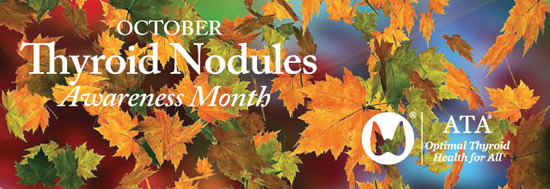
Clinical Thyroidology for the Public summarizes selected research studies discussed in the previous month’s issue of Clinical Thyroidology, an official publication of the American Thyroid Association. Editor-in-chief, Alan Farwell, MD, FACE
Volume 18 Issue 10
Available in pdf format for saving and printing and Web page format for viewing online
PDF Format for Saving and Printing
Clinical Thyroidology for the Public Volume 18 Issue 10 (PDF file, 2.61 MB)
TABLE OF CONTENTS – Web Format
MEDULLARY THYROID CANCER
Does my RET mutation put me at higher risk for medullary thyroid cancer?
Medullary thyroid cancer that runs in families is often associated with mutations in the RET cancer-associated gene. With the increased availability of genetic testing, more patients without clinical indications are obtaining genetic analyses to determine their risk of developing cancer. The aim of the study is to compare the risk of developing and dying from MTC in patients who had clinical indications for the RET positive testing to the risk in patients when the RET mutation was found without a clinical indication on general screening.
West CE, et al. Medullary thyroid cancer risk and mortality in carriers of incidentally identified MEN2A RET variants. JAMA Netw Open 2025;8(6):e251793.
THYROID CANCER
Choosing the right surgery for medullary thyroid cancer
Surgery is the most effective treatment for medullary thyroid cancer. Knowing if a person diagnosed with MTC could avoid a neck dissection would be very useful in making the risk of surgery as low as possible. The goal of this study was to determine if calcitonin levels before surgery and/or doing a thyroid biopsy during total thyroidectomy in people diagnosed with MTC might predict which surgery is best.
Niederle MB, et al. Tailored surgery for medullary thyroid cancer (MTC) based on pretherapeutic basal calcitonin and intraoperative diagnosis of desmoplastic stroma reaction: A proposal for a new surgical concept. Ann Surg Oncol 2025;32:4742–4753.
THYROID CANCER
Calcitonin assay variability and surgical decisionmaking in medullary thyroid carcinoma
Medullary thyroid cancer (MTC) is a rare type of thyroid cancer arising from C-cells in the thyroid, which produce and release into the bloodstream a hormone named calcitonin (CT). The 2015 ATA guidelines make recommendations that the extent of the initial thyroid surgery should be based on blood CT levels, as an indication of neck lymph node involvement. The goal of this study is to update the blood CT cutoff values for predicting the extent of spread of the cancer to the neck lymph node using the newer CT assays and to help determine the best operation for patients with MTC.
Du Y, et al. Updated thresholds of basal calcitonin level and extent of lymph node metastasis in initially treated medullary thyroid cancer. JAMA Otolaryngol Head Neck Surg 2025;151(8):761-767; doi: 10.1001/jamaoto.2025.0542. PMID: 40569620.
THYROID CANCER
Who really needs radioactive iodine therapy for thyroid cancer? Insights from the IoN trial
Radioactive iodine works as a “magic bullet” as it is taken up and stored only by thyroid cells, both normal and cancerous, and destroys them. While in the past most patients were treated with radioactive iodine therapy, the more recent practice is to be selective when considering who would benefit from this treatment. The IoN trial was designed to assess whether observation provided similar outcomes compared to administering radioactive iodine therapy in patients with thyroid cancer with a low-to-intermediate risk of recurrence.
Mallick U, et al. Thyroidectomy with or without postoperative radioiodine for patients with low-risk differentiated thyroid cancer in the UK (IoN): a randomised, multicentre, noninferiority trial. Lancet 2025;406(10498):52-62.doi: 10.1016/ S0140-6736(25)00629-4. PMID: 40543520.
THYROID CANCER
Microwave ablation versus surgery for low-risk papillary thyroid cancer: comparable long-term outcomes
Low-risk thyroid cancers are treated with surgery alone or active surveillance (following the cancer with ultrasound and deferring surgery until the cancer grows significantly). Recently, studies reported the use of thermal ablation techniques to treat small thyroid cancers. In this study, the authors compared the long-term cancer outcomes and complications of microwave ablation vs surgery in patients with small, low risk thyroid cancers.
Fei YL et al. Propensity-matched comparison of microwave ablation and surgical resection for pre-operative T1N0M0 papillary thyroid carcinoma: 5-year follow-up. Eur Radiol. Epub 2025 Aug 6;
HYPOPARATHYROIDISM .
Emergency room visits for hypoparathyroidism: learning from California’s long-term data
Short-term hypoparathyroidism after surgery is relatively common and usually resolves in 1-2 weeks after surgery. Permanent hypoparathyroidism is rare, associated with 1-2% of total thyroidectomies performed by experienced, high volume thyroid surgeons. In this study, the authors analyzed the data of Emergency Department (ED) visits for postoperative hypoparathyroidism up to 2 years after surgery with the goal to comprehend demographic, clinical, and surgical factors associated with these visits.
Woods AL, et al. Hypoparathyroidism After Total Thyroidectomy: A Population-Based Analysis of California Databases. J Surg Res 2025;310:268-274; doi: 10.1016/j.jss.2025.03.061. PMID: 40327904.


